Embracing the lush and captivating world of Colocasia gigantea, commonly known as the Thailand Giant or Giant Elephant Ear, is an adventure that transcends the boundaries of mere gardening. This magnificent species, native to the warm and humid regions of Southeast Asia, offers a unique opportunity to immerse oneself in the alluring aesthetics of the tropics.
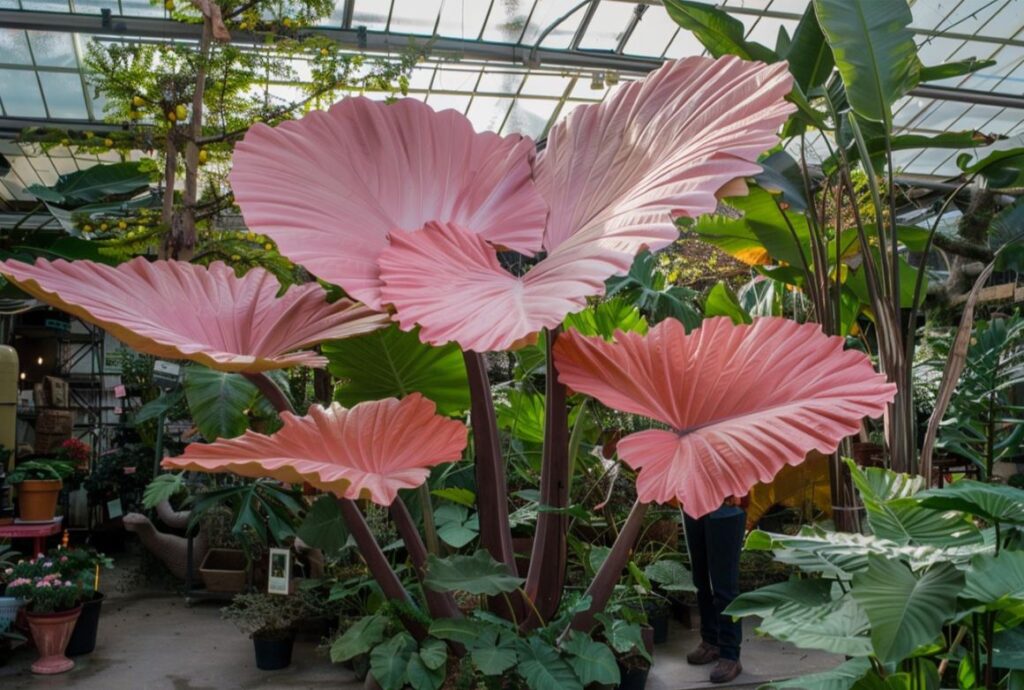
How to Grow Colocasia gigantea (Thailand Giant) and Care
Colocasia gigantea, a true testament to the power and beauty of nature, demands a delicate balance of environmental conditions and attentive care to thrive. By understanding its natural habitat and adapting your cultivation methods accordingly, you can create a harmonious symphony of growth and vitality.
Light Requirements
Striking the Right Balance
Colocasia gigantea, with its grand and impressive foliage, requires a particular balance of light exposure to ensure optimal growth and health. Unlike plants that thrive in full sun, this species prefers a more gentle and filtered approach to light. A location that provides partial sunlight, with dappled shade or filtered shade, will create the ideal conditions for this tropical giant to flourish.
Imagine a summer day where the sun’s rays dance through the canopy of a lush forest, creating a tapestry of light and shadow. This is the essence of the light requirements for Colocasia gigantea. Intense, direct sunlight can scorch and compromise the integrity of the plant’s magnificent leaves, while a completely shaded environment may result in stunted growth and diminished foliage.
The key is to find that sweet spot, that perfect balance where the plant can bask in the warmth and nourishment of the sun’s rays, while also enjoying the protection of filtered shade. This delicate equilibrium allows the plant to thrive, showcasing its grand and captivating leaves in all their glory.
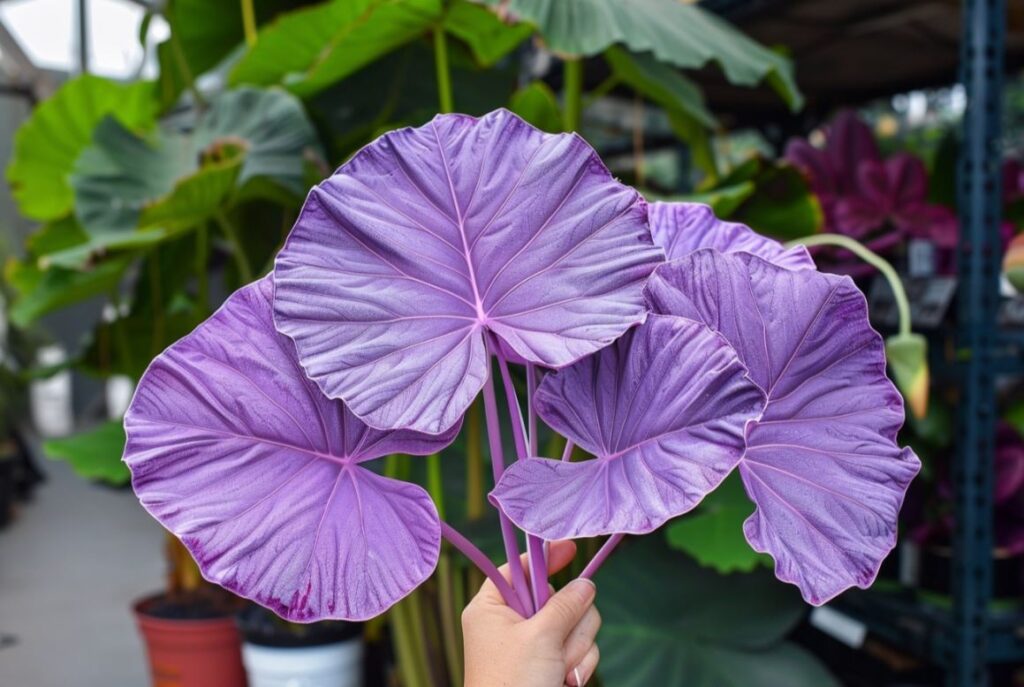
Positioning and Orientation
When selecting a location for your Colocasia gigantea, consider the patterns of light throughout the day. Opt for a spot that receives a combination of partial sun and dappled shade, with the leaves oriented to maximize exposure to the filtered light.
- Avoid placing the plant in direct, unfiltered sunlight, as this can lead to scorching and damage to the leaves.
- Seek out areas with natural shade from trees, buildings, or other structures that can provide the necessary level of filtered light.
- Experiment with different orientations and positions to find the sweet spot where the plant can bask in the right balance of sunlight and shade.
Seasonal Adjustments
As the seasons change, the light patterns in your garden or growing space may also shift. Be prepared to make adjustments to the placement of your Colocasia gigantea to ensure it continues to receive the optimal level of light throughout the year.
- During the summer months, when the sun’s intensity is at its peak, you may need to provide additional shade or move the plant to a more sheltered location.
- As the days grow shorter and the sun’s angle changes in the autumn and winter, you may need to reposition the plant to capture more direct sunlight.
- Observe your plant’s response to the changing light conditions and make necessary adjustments to maintain the delicate balance it requires.
Remember, the goal is to create an environment that mimics the natural habitat of Colocasia gigantea, where the lush foliage can thrive and captivate the senses.
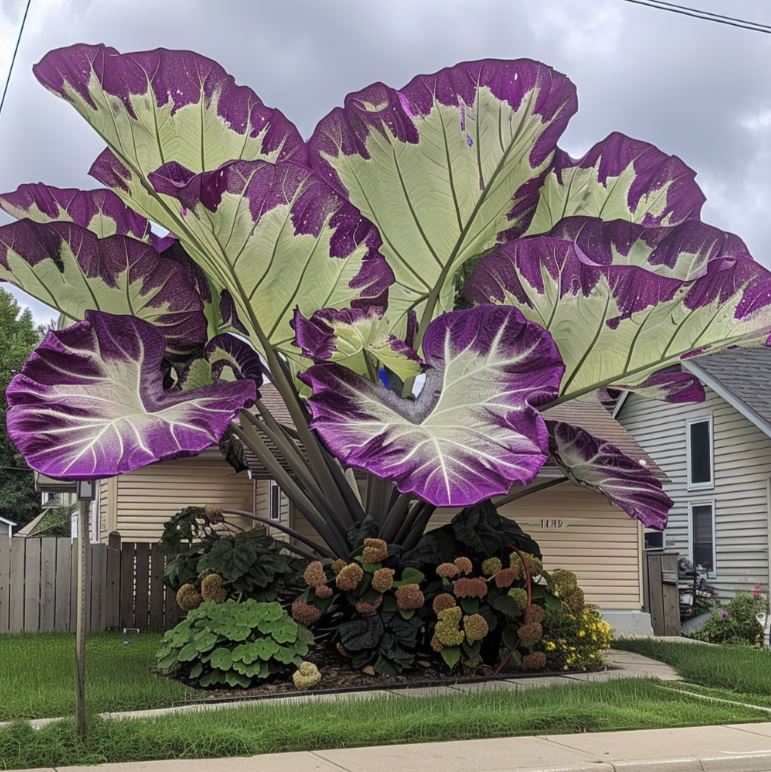
Soil Composition
Crafting the Perfect Substrate
Colocasia gigantea, with its majestic presence, demands a specific soil composition to reach its full potential. This tropical giant is not content with just any ordinary potting mix; it craves a substrate that echoes the rich, well-drained soils of its native Southeast Asian habitats.
Imagine a tapestry of decaying leaves, vibrant earth, and the gentle flow of nutrients, all woven together to create a thriving ecosystem. This is the essence of the soil composition that Colocasia gigantea desires.
Organic Matter and Drainage
To replicate this natural environment, the key is to create a soil that is rich in organic matter and well-drained. By incorporating peat moss, compost, and perlite, you can craft a nutrient-dense substrate that mimics the lush, fertile conditions of the tropics.
- Peat moss provides essential organic matter, helping to retain moisture and nutrients while improving soil structure.
- Compost adds a wealth of beneficial microorganisms and additional nutrients to nourish the plant’s robust growth.
- Perlite enhances drainage, ensuring that the soil does not become waterlogged, which can lead to root rot and other issues.
The combination of these ingredients creates a tapestry of textures and nutrients, much like the harmonious layering of materials found in the plant’s native habitat.
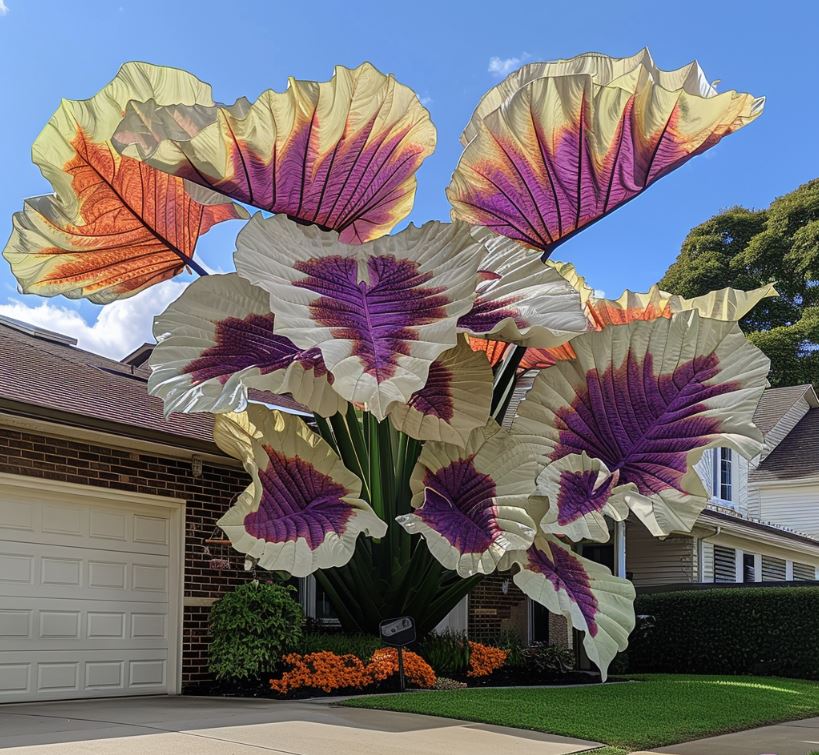
pH Considerations
Colocasia gigantea thrives in slightly acidic soil, with a pH range of 5.5 to 6.5. This acidity helps to unlock the availability of essential nutrients and creates an environment that is well-suited to the plant’s preferences.
- Test your soil’s pH and adjust accordingly, using amendments such as sulfur or lime to fine-tune the acidity.
- Maintain a consistent pH level throughout the plant’s life cycle to ensure optimal nutrient uptake and overall health.
Repotting and Soil Refreshment
As your Colocasia gigantea grows and matures, it will require regular repotting and soil refreshment to maintain the ideal growing conditions.
- When the plant’s roots begin to fill the container, it’s time to transplant it into a larger pot with fresh, nutrient-rich soil.
- During the repotting process, take the opportunity to incorporate additional organic matter and adjust the soil composition as needed.
- By providing a consistent and well-curated soil environment, you can support the plant’s robust growth and vibrant foliage.
Imagine your Colocasia gigantea as a culinary masterpiece, where each ingredient (or soil component) is carefully selected and blended to create a harmonious and nourishing foundation for the plant to thrive.
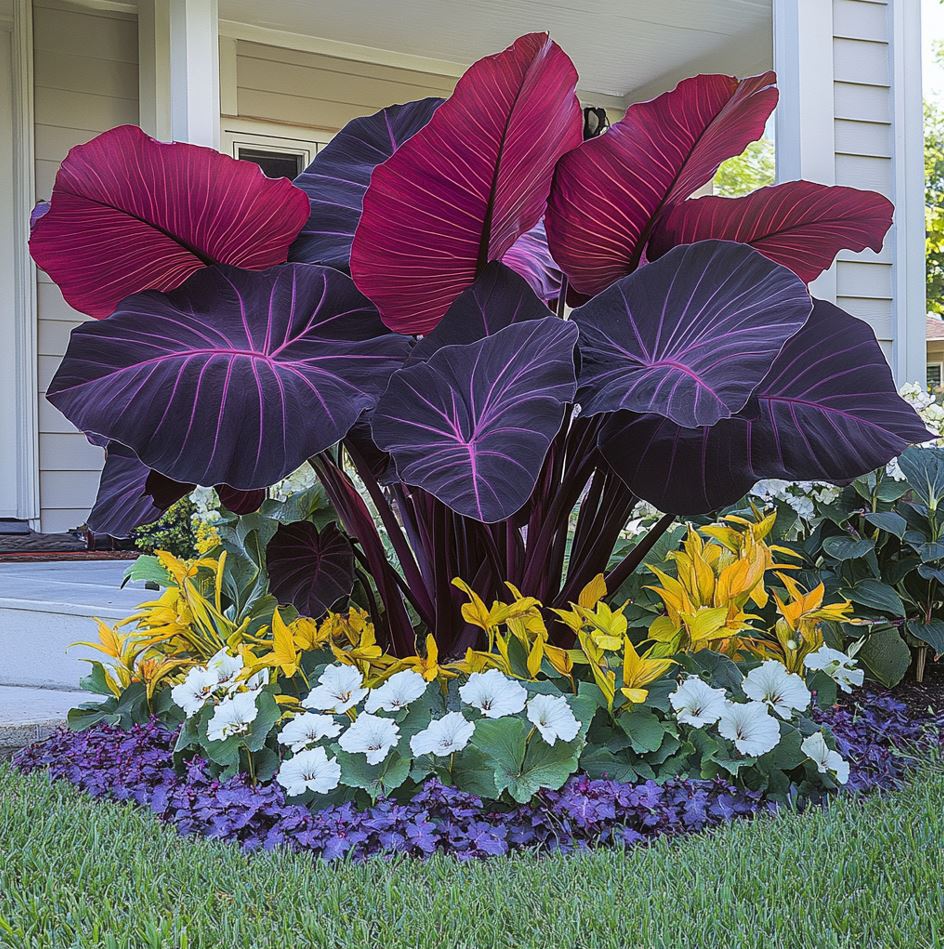
Watering Requirements
Striking the Delicate Balance
Watering is a critical aspect of caring for Colocasia gigantea, the Thailand Giant or Giant Elephant Ear. This tropical marvel thrives in consistently moist conditions, yet it is also susceptible to issues such as root rot if the soil remains waterlogged for too long.
Visualize the gentle rhythm of a tropical rainstorm, where the earth receives a steady and nourishing supply of moisture. This is the essence of the watering requirements for Colocasia gigantea – a delicate balance that mirrors the natural cycles of its native habitat.
Maintaining Consistent Moisture
To ensure the optimal growth and health of your Colocasia gigantea, it is crucial to maintain consistent soil moisture. The goal is to keep the soil consistently moist, without allowing it to become overly saturated or dry out completely.
- Water the plant regularly, keeping the soil consistently moist but not waterlogged.
- Allow the top inch of soil to dry out slightly before watering again, as this helps to prevent root rot and other water-related issues.
- Monitor the soil’s moisture level by gently inserting your finger into the substrate and checking the feel of the soil.
Adjusting for Seasonal Variations
As the seasons change, the watering needs of your Colocasia gigantea may also require adjustment. Pay close attention to the plant’s response and make necessary modifications to ensure it receives the appropriate amount of moisture throughout the year.
- During the warmer, drier months, you may need to water the plant more frequently to maintain consistent moisture levels.
- In cooler or wetter seasons, reduce the watering frequency to prevent the soil from becoming waterlogged.
- Observe the plant’s leaves for signs of stress, such as wilting or yellowing, which can indicate the need to adjust your watering regimen.
Drainage and Containment
Proper drainage is crucial for the well-being of Colocasia gigantea, as this plant is susceptible to root rot if the soil remains saturated for extended periods.
- Ensure that the plant’s container or planting area has adequate drainage holes to allow excess water to escape.
- Consider using a well-draining potting mix or amending the soil with materials like perlite or sand to improve drainage.
- Avoid allowing the plant to sit in water, as this can quickly lead to root rot and other detrimental issues.
Imagine the delicate dance between water and earth, where the plant’s roots are nourished but not smothered. By striking this balance, you can create an environment that mirrors the natural habitat of Colocasia gigantea, allowing it to thrive and captivate with its magnificent foliage.
Fertilization and Growth Support
Nurturing the Tropical Giant
Colocasia gigantea, the Thailand Giant or Giant Elephant Ear, is a remarkable plant that demands a thoughtful approach to fertilization and growth support. Just as a skilled chef carefully seasons a complex dish, the cultivation of this tropical marvel requires a nuanced understanding of its nutritional needs and the importance of providing the right support.
Balanced Fertilization
To encourage the robust growth and vibrant foliage of Colocasia gigantea, a balanced, water-soluble fertilizer should be applied regularly. This approach mirrors the way nature provides a harmonious blend of nutrients to the plant’s native habitat.
- Use a balanced, water-soluble fertilizer with a ratio such as 20-20-20 or 10-10-10, which provides a well-rounded supply of essential macro and micronutrients.
- Apply the fertilizer monthly during the growing season, following the manufacturer’s instructions for proper dilution and application.
- Avoid over-fertilizing, as excessive nutrient levels can lead to lush foliage at the expense of root health and overall plant vigor.
Enhancing Nutrient Uptake
In addition to regular fertilization, you can further support the growth and development of Colocasia gigantea by providing supplemental nutrients and enhancing the plant’s ability to absorb them.
- Consider using a seaweed-based or kelp-derived fertilizer, which can help to strengthen the plant’s overall health and resilience.
- Introduce beneficial microorganisms, such as mycorrhizal fungi, to the soil, as these can symbiotically enhance the plant’s nutrient uptake and overall vitality.
- Regularly inspect the plant’s leaves for any signs of nutrient deficiencies, and address them promptly with targeted supplementation.
Growth Support and Staking
As Colocasia gigantea matures and produces its grand, imposing leaves, the plant may require additional support to maintain its structural integrity and prevent damage.
- Invest in sturdy stakes or trellises that can gently guide the plant’s growth and provide the necessary support without restricting its natural expansion.
- Carefully tie the plant’s leaves and stems to the support structure, using soft, non-abrasive materials to avoid causing harm.
- Adjust the support system as the plant grows, ensuring that it keeps pace with the plant’s increasing size and weight.
Imagine your Colocasia gigantea as a culinary masterpiece, where every element – from the seasonings to the presentation – contributes to the overall harmony and enjoyment of the dish. By nurturing the plant with a balanced, thoughtful approach to fertilization and growth support, you can help it reach its full potential and captivate all who encounter its magnificent presence.
Pest Management and Common Issues
Vigilance and Harmony in the Tropical Oasis
When cultivating the majestic Colocasia gigantea, the Thailand Giant or Giant Elephant Ear, it is essential to remain vigilant and proactive in addressing any potential pests or common issues that may arise. Just as a skilled gardener must act as a custodian of the rainforest, safeguarding the delicate balance of this tropical marvel requires a keen eye and a gentle, harmonious approach.
Pest Identification and Control
The lush, expansive leaves of Colocasia gigantea can sometimes attract the unwanted attention of pests, such as spider mites and aphids. These intruders may target the undersides of the leaves, disrupting the plant’s health and vigor.
- Regularly inspect the plant, paying close attention to the leaf undersides and other hidden areas, to identify any signs of pest infestations.
- If pests are detected, consider utilizing natural, environmentally-friendly methods of control, such as introducing beneficial insects or applying insecticidal soap.
- Avoid harsh chemical pesticides, as they can disrupt the delicate balance of the plant’s ecosystem and potentially harm the plant itself.
Addressing Common Issues
In addition to pests, Colocasia gigantea may encounter other common issues that require attentive care and problem-solving.
Leaf Discoloration and Damage
- Yellowing or browning leaves may indicate issues such as nutrient deficiencies, excessive sun exposure, or problems with watering.
- Promptly address any signs of leaf discoloration or damage to prevent further decline and maintain the plant’s vibrant appearance.
Wilting or Drooping Leaves
- Wilting or drooping leaves can be a sign of stress, often caused by underwatering, overwatering, or other environmental factors.
- Adjust your watering regimen and monitor the plant’s response to restore the leaves to their majestic, upright position.
Root Rot
- As a plant that thrives in moist conditions, Colocasia gigantea is susceptible to root rot if the soil becomes waterlogged for extended periods.
- Carefully examine the plant’s roots for any signs of decay, and take prompt action to address the issue, such as improving drainage or adjusting watering practices.
By maintaining a vigilant and harmonious approach to pest management and addressing common issues, you can create an environment that mirrors the natural balance of the plant’s native habitat, allowing your Colocasia gigantea to thrive and captivate with its magnificent presence.
Propagation Techniques
Sharing the Tropical Abundance
When cultivating the majestic Colocasia gigantea, the Thailand Giant or Giant Elephant Ear, the opportunity to propagate and share this tropical marvel with others presents itself as a natural extension of the gardening journey. Just as the plant’s native habitat is a tapestry of generosity, where diverse species coexist and support one another, the act of propagation allows you to nurture and distribute the beauty of Colocasia gigantea to fellow enthusiasts and your own growing garden.
Division: The Path of Abundance
The most effective method for propagating Colocasia gigantea is through division, a technique that mirrors the plant’s natural tendency to spread and expand its reach. By carefully separating the tubers during the repotting process, you can not only ensure the continued growth of your existing plant but also create new, vibrant specimens to share or incorporate into your own growing space.
- When repotting your Colocasia gigantea, gently examine the root system and identify potential division points.
- Carefully divide the tubers, ensuring that each separated clump has a healthy set of roots, as well as a portion of the plant’s crown.
- Treat the divided sections with care, planting them in well-prepared soil and providing the same attentive care as your original plant.
Sharing the Tropical Delight
As your Colocasia gigantea thrives and matures, the opportunity to share its captivating presence with fellow gardeners and enthusiasts presents itself as a natural extension of the cultivation journey.
- Consider gifting divisions of your Colocasia gigantea to friends, family, or local gardening groups, allowing the tropical delight to spread and enrich the lives of others.
- Engage with online communities of Colocasia gigantea enthusiasts, sharing your experiences and offering advice or surplus plants to those who share your passion for this magnificent species.
- Participate in local plant swaps or sales, where you can connect with fellow gardeners and contribute to the propagation and appreciation of this tropical giant.
By embracing the act of propagation, you not only ensure the continued growth and abundance of your own Colocasia gigantea but also foster a sense of community and shared appreciation for the beauty and resilience of this remarkable plant.
Conclusion
Cultivating the majestic Colocasia gigantea, the Thailand Giant or Giant Elephant Ear, is a journey that transcends the boundaries of mere gardening. It is an opportunity to immerse oneself in the captivating aesthetics of the tropics, to forge a profound connection with nature’s cycles, and to embark on a collaborative effort that reflects the harmony and generosity found in the plant’s native habitat.
Through the delicate balance of light requirements, the crafting of a nutrient-rich soil substrate, the careful management of watering needs, and the thoughtful approach to fertilization and growth support, you can create an environment that allows this tropical marvel to thrive and captivate all who encounter it.
Moreover, the vigilance required in addressing pests and common issues, coupled with the act of propagation and sharing, echoes the responsibilities, patience, and adaptability that are inherent to the human experience. As each season passes and you witness the growth and transformation of your Colocasia gigantea, you are invited to reflect on your own role as a custodian of the natural world, a seeker of harmony,




